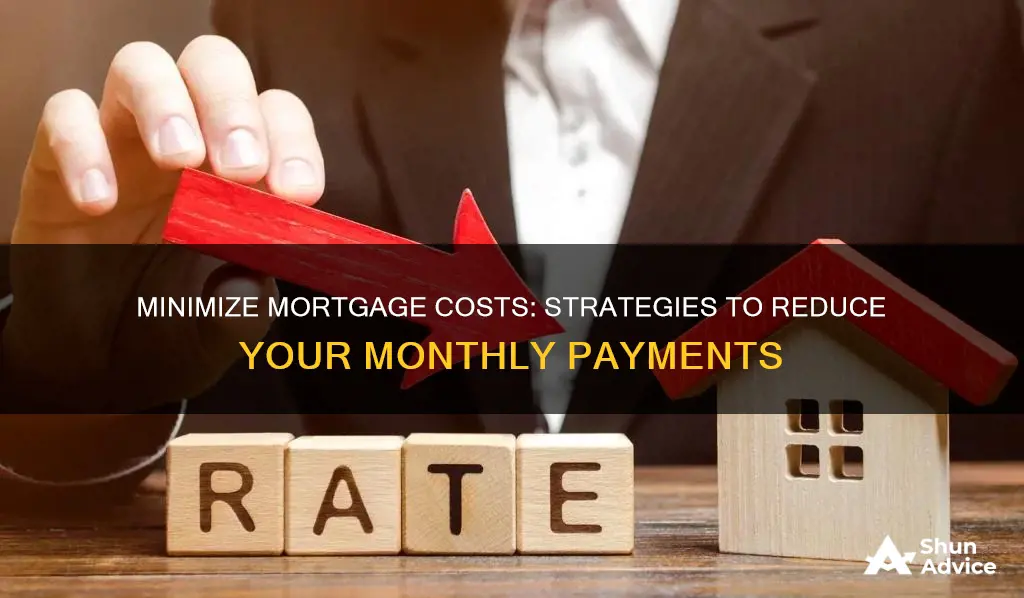
Owning a home is a dream for many, but the mortgage that comes with it can be a nightmare. If you're looking to lower your monthly mortgage payments, you're not alone. There are several strategies to reduce your housing costs and free up funds for other financial commitments. From refinancing to negotiating terms, let's explore the options available to help you keep your home and your financial sanity. Understanding your mortgage payment components, such as principal, interest, taxes, and insurance, is key to making informed decisions and modifications to lower your payments.
How to lower your mortgage:
| Characteristics | Values |
|---|---|
| Refinancing | A basic rate-and-term refinance offers a lower interest rate, a longer term, or both. |
| Renegotiating | If your financial situation has improved, you may be able to negotiate a lower interest rate. |
| Recasting | Making a lump-sum payment towards the principal lowers the monthly payment amount due to a lower principal balance. |
| Loan modification | If you can't afford payments due to a major life event, you may qualify for a loan modification, which changes the terms of the loan. |
| Lower insurance | Shop around for cheaper homeowners insurance. |
| Lower taxes | If you're in a high property tax area, you may be able to lower your property taxes by arguing your house's value. |
| Bi-weekly payments | Opting for bi-weekly payments can smooth out your cash flow and help pay down your balance faster. |
| Discount points | You can buy mortgage discount points to lower your interest rate, but this increases upfront costs. |
| Rate locks | Negotiate rate locks with float-down provisions to secure a lower rate if the market rate drops. |
What You'll Learn

Lower your homeowners insurance
Homeowners insurance premiums are rolled into your monthly mortgage payment, so lowering your insurance premium will help shrink that monthly bill. One of the simplest ways to save money on your homeowners insurance is to review your possessions and policy each year to ensure you're not overpaying for something you don't need. For example, if you have items such as jewellery, technical equipment, and art covered under a separate endorsement, consider whether these items have depreciated since you insured them. If so, you may want to reduce or cancel that extra coverage from your policy.
You can also save money by bundling your homeowners insurance with your auto insurance and other policies. Insurance companies that offer homeowners, auto, and liability coverage will generally give a discount of 5 to 15% off your premium if you buy two or more policies. You could also be eligible for a discount based on your employer or job status.
Another way to lower your premium is to increase your deductible. Just make sure you know what coverage your lender requires if you’re reducing or eliminating anything.
You can also access discounts by installing smoke detectors, burglar alarms, monitored security systems, and deadbolt locks. A high-end sprinkler system could also trim your premium, but they can be expensive, so find out what type of sprinkler system your insurer recommends and whether the annual insurance savings will offset the cost.
Finally, improving your credit score can help lower your premium. Focus on paying bills on time and reducing credit card balances to boost your score.
Who Services My Mortgage? Find Out Now
You may want to see also

Modify the principal, interest, taxes or insurance
Modifying the principal, interest, taxes, or insurance is a way to lower your monthly mortgage payments. Here are some strategies to consider:
Principal
- Making a large principal payment can help you recast the loan with no fees, reducing your monthly payments.
- If you have the funds, making a lump-sum payment towards the principal can lower the monthly payments for the remainder of the loan term.
- You can also consider a loan modification, which may involve reducing the principal balance.
Interest
- Keep an eye on the market for lower interest rates than your current one. When rates drop, contact your lender to lock in a lower rate.
- You can also "buy down" your interest rate by purchasing mortgage discount points as part of your closing costs. Each point is 1% of the loan amount and typically results in an interest rate reduction of 0.25% to 0.5%.
- Refinancing your mortgage can also lead to a lower interest rate, but it will also change the duration and monthly payments.
- If you are a lower-income family, you may qualify for mortgage assistance payments under Section 235 of the National Housing Act, where part or all of the interest on your mortgage may be paid for you.
- Additionally, you can deduct home mortgage interest on the first $750,000 ($375,000 if married and filing separately) of indebtedness.
Taxes
- If you live in an area with high property taxes, you may be able to lower your property tax bill by contesting your home's value assessment. However, this typically only happens once a year in most areas.
- Tax assessments may sometimes be too high following real estate market corrections or local rezoning, so consider appealing to the relevant state or local decision-makers if you believe your property's value is inaccurately assessed.
Insurance
- Shop around for cheaper homeowners insurance. You may find more affordable options or discover that you are eligible for discounts based on home features, your employer, or job status.
- Bundling your homeowners insurance with other policies, such as auto insurance, can often result in cost savings.
- Increasing your insurance deductible can also lead to lower premiums.
- If you have a conventional loan and have paid off a significant portion, you may be able to cancel your private mortgage insurance (PMI), which is not technically part of your mortgage payment but is typically sent to your lender in the same payment.
Recognizing Tracker Mortgages: What You Need to Know
You may want to see also

Refinance your mortgage
Refinancing your mortgage can be a great way to save money, but it's important to understand the process and consider the upfront costs to make sure it's the right decision for you.
When you refinance, you're essentially trading in your current mortgage for a new one, often with a different lender. This new mortgage is used to pay off the old one, leaving you with a single loan and, usually, a single monthly payment. There are several reasons why someone might choose to refinance their mortgage, including:
- Lowering their monthly payment
- Lowering their interest rate
- Shortening their loan term
- Tapping into their home's equity
- Paying off their loan faster
- Removing or adding someone to the mortgage
- Getting rid of FHA mortgage insurance
- Switching from an adjustable-rate to a fixed-rate loan
There are several types of refinancing options, including rate and term refinance, which allows you to change the interest rate and loan terms to better suit your financial situation. Another option is a cash-in refinance, where you contribute a lump sum towards your mortgage to increase equity and decrease the amount owed, which can result in lower monthly payments and a lower interest rate.
It's important to note that refinancing usually comes with closing costs and fees, which can impact whether the lower monthly payments are worth it in the long run. Additionally, an appraisal of your home's value will be required to determine what options are available to you, such as how much cash you can get if you're refinancing to take cash out.
Overall, refinancing can be a great way to leverage your home as an investment and make your mortgage work better for your financial situation.
Understanding Mortgage Foreclosure: Your Guide to the Process
You may want to see also

Make additional payments
Making additional payments is a great way to lower your mortgage payments and gain financial flexibility. Here are some strategies to consider:
Mortgage Recasting
Mortgage recasting allows you to make a lump-sum payment towards the principal amount. Your lender will then recalculate your monthly payments based on the new balance, resulting in lower monthly payments and less total interest over the loan's life. While not all lenders offer this option, it can be a great way to reduce your payments without refinancing. Keep in mind that lenders may charge an administrative fee for recasting, so be sure to do the math and ensure it aligns with your financial goals.
Lower Your Homeowners Insurance
If your homeowners insurance is part of your monthly mortgage payment, shopping for a better rate can help lower your overall payment. Call different insurance companies to get quotes, and don't hesitate to ask about discounts. You may be eligible for discounts based on security systems, fire alarms, or even your job status. Additionally, consider bundling your homeowners insurance with other policies, such as auto insurance, to save money. Review your coverage to ensure you're not overpaying for something you don't need, and if affordable, consider raising your deductibles to lower your premiums.
Modify the Principal, Interest, Taxes, or Insurance
Focusing on modifying the principal, interest, taxes, or insurance components of your mortgage can lead to significant savings. For instance, making a larger down payment reduces the loan principal and the interest paid over the loan's life. Additionally, keep an eye on the market for lower interest rates than your current rate. When rates drop, contact your lender to lock in the lower rate. You can also consider buying mortgage discount points, which are a form of prepaid interest that reduces your interest rate.
Bi-Weekly Mortgage Payment Schedule
Opting for a bi-weekly mortgage payment schedule can reduce your monthly payment burden. Instead of one large monthly payment, your payment is halved and made every two weeks. This not only improves your cash flow but also results in an extra monthly payment each year, helping you pay down your balance faster.
Understanding Your Mortgage: Am I Eligible?
You may want to see also

Lower your property taxes
Property taxes are usually charged annually and can be a significant expense for homeowners. If you're looking to lower your property taxes, there are a few strategies you can consider:
- Assess your property's value: Property taxes are typically calculated based on the assessed value of your home. You can request a reassessment of your property's value if you believe it has decreased since your last evaluation. This could result in a lower tax bill. Keep in mind that the process for reassessing property values may vary depending on your location, and there might be a fee involved.
- Take advantage of exemptions and abatements: Depending on your location, there may be property tax exemptions or abatements available. These are often offered for specific groups, such as seniors, veterans, or individuals with disabilities. Research the exemptions and abatements offered in your area to see if you qualify.
- Appeal your tax assessment: If you believe your property has been overvalued or unfairly assessed, you can appeal the assessment. This process can vary by jurisdiction, but it typically involves filing an appeal with the appropriate government agency or tax assessor's office. You may need to provide evidence, such as comparable properties with lower assessments, to support your case.
- Pay your taxes early: In some cases, you may be able to receive a discount on your property taxes by paying them early. Check with your local tax office to see if this option is available and if there are any specific requirements or deadlines.
- Keep up with market trends: Property taxes can fluctuate based on market conditions and local budget needs. Stay informed about market trends and be proactive in understanding how they might impact your property taxes. If you anticipate a significant increase, you can start planning accordingly.
- Consider relocation: If your property taxes are consistently high and unaffordable, you may consider relocating to an area with lower property tax rates. This, of course, is a significant decision that involves various factors, but it could provide financial relief if other options are limited.
Remember that the effectiveness of these strategies may vary depending on your specific circumstances and location. It is always a good idea to consult with a financial professional or tax advisor to determine the best course of action for your situation.
Navigating VA Mortgage Problems: A Step-by-Step Guide
You may want to see also
Frequently asked questions
You can lower your mortgage payment by making additional payments as part of your scheduled amortization. You can also shop around for a better homeowners insurance rate, as this is often paid as part of your monthly mortgage payment.
You can call around to insurance companies to get quotes and ask about discounts. You may be eligible for a discount based on your job or security features in your home.
Mortgage recasting is a process that keeps your current loan in place and lowers your monthly payment due to a lower principal balance. Most conventional loan lenders allow you to recast your mortgage, but it is not available for government-backed mortgages.
Refinancing is when you replace your existing mortgage loan with a new one that has different rates or terms. It should cost comfortably under $1000 if you don't need a new appraisal.
If your financial situation has improved since you first signed your loan, you could potentially negotiate your fixed-rate mortgage to a lower interest rate. This is especially relevant if your credit score has increased or if overall lending rates have decreased.







